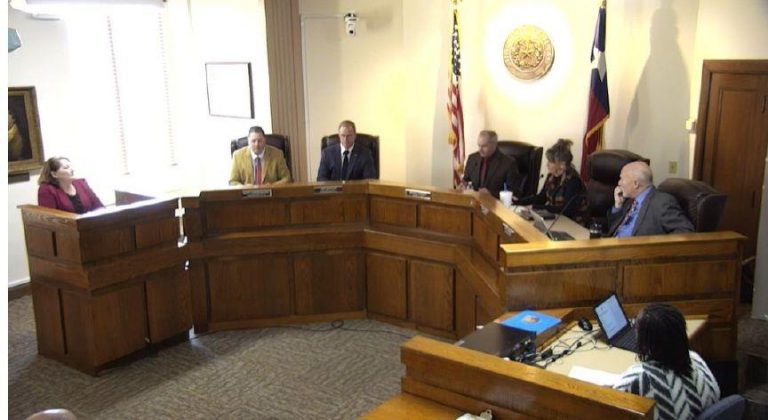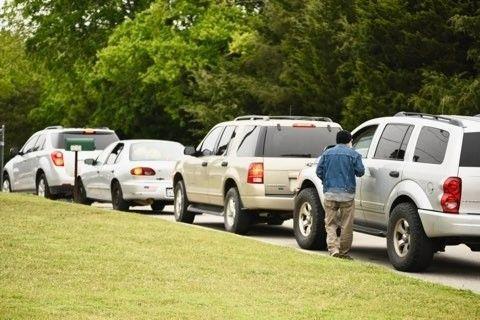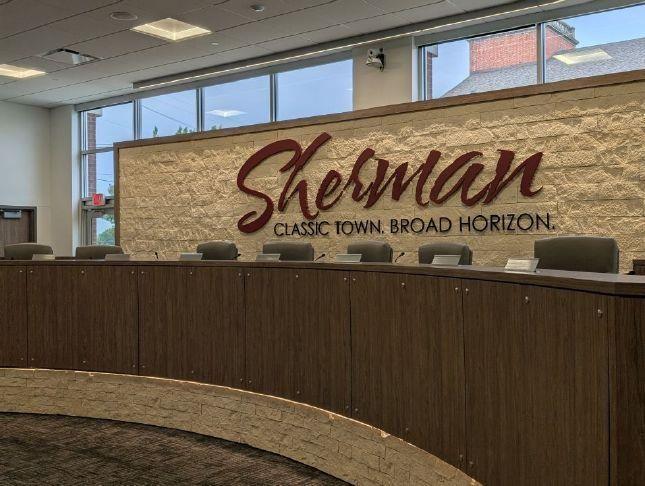Grayson County commissioners meet most Tuesday mornings of the year and discuss a variety of issues but for the past few years including this year, most of those issues can be traced back to one simple word: expansion.
Whether they are considering hundred home subdivision plats or wrestling with the county budget or trying to plan for future generations of jail inmates, expansion is always a part of the equation and not always in a positive way.
Emergency Service District no. 1
One issue that has been looming in the county for years and came to the forefront this year is that of emergency services in the unincorporated areas of the county.
In early December, county commissioners took a step toward a possible solution to that problem by accepting a petition for the first emergency service district in the county. The district would basically be a taxing entity and the people who live within that district would pay an additional tax to support emergency services in that district.
Grayson County Clerk Deana Patterson said since the court accepted the petition to create the district, there will be a public hearing on the matter set for January 21, 2025.
Grayson County Emergency Services District no. 1, if it is created, will be in Precinct 4. Matt Hardenburg, the commissioner for that precinct, said it will be out on the peninsula.
County leaders expressed their desire to see more of this type of solution as the county continues to struggle with how to provide emergency services in the unincorporated areas. All of that while pointing out that the county is not actually required to provide those emergency services.
Patterson said this is the first such petition the county has received and there are rules set out by statue about how the process should be handled. She also said she has consulted with other counties who have already been through this process about how things should go.
“Between now and the day of the public hearing there’s notices that have to be posted and published in the local newspaper. And then once we get to the 21st, we’ll have everything in place for you to be able to vote to accept the petition and order an election because it does require an election and that election would be held on May 3, 2025, with the city and school elections,” Patterson told commissioners.
“I think all of us are interested in the process of establishing these because it’s going to become a big issue,” Commissioner Jeff Whitmire said.
Patterson explained that one must not only own property in the district but must be registered to vote in that district to take part in the vote on whether or not the district is created so someone who owns property in the district, but lives and is registered to vote in Dallas, would not be able to vote in the election in Grayson County.
There was then some discussion about the fact that there are a lot of different factors that might enter into forming such a district like whether or not there is a city located within it, or a city’s extra territorial jurisdiction is located within the proposed ESD.
Patterson said this first one doesn’t contain any of those factors so they will continue to research how those factors impact the needed procedures as they move forward.
“This ESD is extremely important Grayson County,” Commissioner Art Arthur said. “The things that’s coming to light in this one hopefully make it a matter of months, not years in a transition to get everybody on board. Quite honestly, I think your leg work is going to give us an opportunity to make a run at the rest of the county. It may not work but that would be ideal would be to maybe bring the entire county under this district.”
In the past, the bigger cities in the county have worked with the county to provide emergency services in those areas at a cost to the county. But as those cities continue to grow, they have put the county on notice that that solution is not sustainable at any cost.
“Most of the public who live out in the unincorporated areas don’t understand that they have a very real risk of losing fire and ambulance coverage in the near future,” he said. “We’ve been relying on cities (for that coverage) and cities are not able to actually be able to handle that load anymore. So, there is going to have to be a different funding source, and that funding cannot include people who are already paying for those services. This will affect me in the future because I live in the unincorporated areas, so I understand that’s going to be another tax but without fire service, it’s going to be very difficult for you to have insurance in the future on your home, and if you don’t have insurance on your home, you probably aren’t going to be able to have a loan on your home, so that mortgage goes away so it is a very important thing.”
GRayson County County Jail
Another issue that comes along with growth and on which the county spent a lot of time this year is the county’s jail size. After literally years of discussion, the county finally broke ground in December on the much talked about expansion of the jail in downtown Sherman.
The 166-bed expansion of the jail at its current location of 200 South Crockett Street in Sherman has been in the works for at least two years. But expanding the jail has been a topic of discussion and work for county employees for years before that.
In November, commissioners approved a guaranteed maximum price for the project of $30,872,639. That amount did not include soft costs like furnishings.
The all in the price for the project is expected to come in around $39.8 million for the expansion that will be about 34,660 square feet and be made out of steel. The price per bed for the project was listed at $142,595. Twenty-two of those beds are expected to be separation cells.
The project is estimated to cost $682.94 per square foot.
The information technology closet will be located on that first floor. The corridor for people to access the cells for things like repairs will be behind the cells which will allow plumbers to work on toilets without actually having to go into the cells.
The next level of the renovation will be between the first and second floors and include the second tier of cells. The elevated staff position will be on the second floor and look into both tiers of cells as well as the recreation area.
The second floor will also include the recreation area which is an enclosed yard with natural light exposure. That level also has some addition separation cells, roof access and a laundry room.
In March, Grayson County Sheriff-elect Tony Bennie told commissioners the planned expansion has already received a variance from the state agency charged with regulating jails.
Bennie said the jail currently has 72 percent dormitory style housing of its inmates. Dormitory housing in the Grayson County jail has 24 beds per pod and there are six such pods. The state would like that number to be under 40 percent dormitory space. However, Bennie said, the expansion will allow the county to bring that number down to 51 percent.
The current plan for renovations and expansion are greatly scaled back from what was originally planned.
In 2023, county leaders approached the city with plans to expand the jail to increase its inmate capacity by 200-250 beds. The request sparked some opposition from city leaders at the time who opposed the expansion of jail operations in downtown due to the impact the facility had on area businesses.
Opposition to the large expansion was not the only hurdle the county faced. The county originally planned to spend about $37 million on that 200 to 250 expansion but by the time they were ready to start the project, the projected cost had risen to about $73 million.
That plan included renovation of the sallyport and other areas of the jail. But that price tag caused county leaders to go back to the drawing board and come up with the more affordable option. County leaders attributed the difference in cost to a lack of communication between architects and the construction manager at risk.
The jail was last expanded in 2012 when the county added 96 beds for a price tag of $4.9 million according to previously published reports.
Change in county offices
As the county population continues to grow, so does the number of people required to run county government. As that grows, so does the need for space for those folks to work. Commissioners started addressing that issue this fall by announcing the relocation of two county offices that will likely lead to changes in location of many others.
In early September, commissioners approved the purchase of a building at 2027 Texoma Parkway for $1,308,530. Commissioners plan to move Adult Probation out of downtown and move the Tax and Vehicle Registration offices out of the Grayson County Courthouse to the location currently used by adult probation.
Grayson County Judge Bruce Dawsey said this move will not only provide easier access to one of the county’s busiest offices for county residents, it will also cut down on traffic in downtown area.
“We are going to do a tax note. It is a government finance mechanism instead of a certificate of obligation bond we can do a tax note.” Dawsey said of how the county intends to pay for the move. “It’s basically a short-term loan that we are getting for 3.1 percent interest.” The loan will be for $2 million, and the court is hoping to be able to use the money left over after purchasing the building the on Texoma Parkway to pay for the renovations to the buildings and offices involved in the move.
In December, commissioners approved a preliminary budget of $400,000 to make the building at 2027 Texoma Parkway ready for Adult Probation. According to information in the meeting’s agenda package the money will come from the budget’s professional services line item.
Dawsey said it should take about nine months to get the Adult Probation Department moved to Texoma Parkway. And then about six months more to get the Tax and Registration Offices moved.
“So, we are looking at a year to 18-or-16 months total for all of the pieces to be moved,” Dawsey said.
He said that the space currently being used for Tax and Vehicle Registration offices will then be considered for other county needs as they are very limited on space in both the courthouse and the Justice Center.
Growth management considered
As more and more people continue to move into the county’s unincorporated areas, it becomes more vital that the county set some rules for the growth. However, Texas limits what counties can do to control growth. Back in July, county leaders approved revisions to the Grayson County Subdivision Regulations and Engineering and Design Standards manual.
The subdivision regulations and Design Standards manual changes were designed to make sure that the growth headed into Grayson County does not impede upon the quality of life of those who live in the county. Whitmire said over the years the county had subdivision regulations, OSSF regulations and right-of-way regulations all in different places. The manual changes are an effort to bring all of that together and make it easier for the county to keep a watch over things as well as for those seeking to build to make sure they have everything done well.
He said even these new regulations were built on the idea that most dwellings in the unincorporated areas of the county would be using septic systems and would not be part of large developments with their own sewer systems. But now, there are a couple of those types of communities in the work, so the county will have to look at what types of regulations it is allowed to set for those types of communities.
Whitmire said the changes will not apply to things already in place.
“Technically, it looks like we’ve written a completely new document. Which we have, but because there is an existing regulation this is technically a revision of our regulations. Many parts of this are the same. We have codified into the regulations some things that were listed in the right-of-way regulations previously,” Whitmire said.
As an example, he explained that previously the county had a 30-foot minimum width on county roads, and they are moving that to 60 -foot minimum width on roads in subdivisions.
“We’ve used the word subdivision, that doesn’t mean a neighborhood,” he said. “That means if you are going to divide a piece of property, that becomes a subdivision. So, these regulations are what we will apply to any new plat request that come through. It does not apply to older properties.”
Two of the things that the state does allow counties to do to regulate growth is to set a minimum width and setback on county roads and those are both addressed in these regulations.




